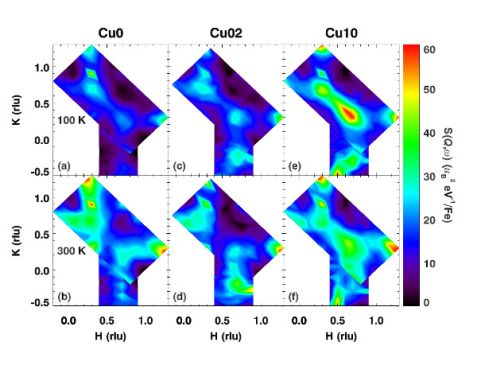MLZ ist eine Kooperation aus:
 > Technische Universität München
> Technische Universität München > Helmholtz-Zentrum Hereon
> Helmholtz-Zentrum Hereon
 > Forschungszentrum Jülich
> Forschungszentrum Jülich
MLZ ist Mitglied in:
 > LENS
> LENS > ERF-AISBL
> ERF-AISBL
MLZ in den sozialen Medien:

MLZ
Lichtenbergstr.1
85748 Garching
Enhanced low-energy magnetic excitations in the superconductor Fe0.98-zCuzTe0.5Se0.5
J. Wen1,2,3, S. Li1, Z. Xu4, C. Zhang4, M. Matsuda5, O. Sobolev6, J. T. Park6, A. D. Christianson5, E. Bourret-Courchesne7, Q. Li4, G. Gu4, D.-H. Lee2,3, J. M. Tranquada4, G. Xu4, and R. J. Birgeneau2,3,8
1National Laboratory of Solid State Microstructures and Department of Physics, Nanjing University, Nanjing, China
2Department of Physics, University of California, Berkeley, California, USA
3Materials Science Division, Lawrence Berkeley National Laboratory, Berkeley, California, USA
4Condensed Matter Physics and Materials Science Department, Brookhaven National Laboratory, Upton, New York, USA
5Quantum Condensed Matter Physics, Oak Ridge National Laboratory, Oak Ridge, Tennesse, USA
6Heinz Maier-Leibnitz Zentrum (MLZ), Technische Universität München, Garching, Germany
7Life Sciences Division, Lawrence Berkeley National Laboratory, Berkeley, California, USA
8Department of Materials Science and Enginnering, University of California, Berkeley, California, USA
We use Cu to replace Fe in Fe0.98Te0.5Se0.5, an Fe-based superconductor with a superconducting temperature (Tc) of about 15 K, and perform inelastic neutron scattering measurements on the samples. We find that the low-energy magnetic excitations are strengthened, contrary to expectation, but consistent with the idea that the main effect of Cu doping is to localize conduction states, thereby suppressing the itinerancy and enhancing the low-energy magnetic excitations.
Roles of 3d transition metal substitution
Understanding how superconductivity emerges from their non-superconducting parent compounds has been one of the central topics in condensed matter physics. For example, in BaFe2As2 (Ba122), initially, it is believed that substituting Fe with 3d transition metals such as Co and Ni that act as effective electron dopants renders the superconductivity. [1] Such approaches typically describe the doping effects based on a rigid-band-shift model. [2] However, such a model has faced serious challenges from both the experimental and theoretical perspectives, [3] each of which indicates the inadequacy of a rigid-band description. Furthermore, there is a dichotomy between Co/Ni and Cu substitution effects in terms of the emergence of superconductivity. [1] In this work, we explore the effects of transition metal substitution by carrying out inelastic neutron scattering measurements on thermal neutron three-axes spectrometers including PUMA at MLZ on a different Fe-based superconductor system, namely Fe1+yTe1-xSex.
Cu-induced localizations
We use Cu to substitute for Fe in Fe0.98Te0.5Se0.5, and measure how the low-energy magnetic excitations evolve as a function of Cu concentration. We studied three samples of Fe0.98-zCuzTe0.5Se0.5 with nominal z = 0, 0.02, and 0.1, which we labeled as Cu0, Cu02, and Cu10. Without Cu substitution, the sample has the highest Tc of ~15 K among the Fe1+yTe1-xSex system. The Tc is suppressed rapidly by the Cu doping—with 0.02-Cu substitution, it is reduced to 8 K; with 10% Cu doping, the sample is no longer superconducting, and behaves like an insulator.
The low-energy (≤12 meV) magnetic excitations respond to the Cu doping by showing enhanced spectral weight and increased dynamical spin-spin correlation lengths. The key results are summarized in figure 1. From the 100 K data in figure 1 (the upper panels), it is clear that the spectral weight is greatly enhanced in the Cu10 sample compared to that of the Cu0 and Cu02 samples. By analyzing the data, it is found that the dynamical spin-spin correlation length also becomes larger with Cu substitution. For each sample, as the temperature increases from 100 to 300 K, the magnetic excitations become broader, especially along the [110] direction. However the temperature dependence of the Cu10 sample differs from that of the other two in an important way. As shown in figure 2, while the scattering intensity for all three samples is comparable at 300 K, only in the case of Cu10 does it grow substantially on cooling to 100 K.
We have studied the energy dependence of the enhancement on the integrated intensities for the [1-10] scan for the Cu10 sample at 100 K compared to that at 300 K, and the results are shown in the inset of figure 2©. At low energies, for example, from 2–10 meV, the integrated intensities are almost doubled.
Combining these results, we conclude that in the Cu10 sample, the magnetic scattering is significantly strengthened. The results are in contrast to the expectation that using weakly non-magnetic Cu to replace magnetic Fe2+ suppresses the magnetic correlations. The behavior that we observe can naturally be explained by assuming that the main effect of Cu doping is to localize conduction states, thereby suppressing the itinerancy. As a result, either the local moments are enhanced, or the spin fluctuation rate is reduced, and the spectral weight is transferred to low energies. Either case will give rise to an enhancement of the low-energy magnetic scattering. Our results demonstrate that Cu substitution in the Fe1+yTe1-xSex system cannot be described by a rigid-band-shift model.
References:
[1] P. C. Canfield et al., Phys. Rev. B 80, 060501® (2009).
[2] M. Neupane et al., Phys. Rev. B 83, 094522 (2011).
[3] G. Levy et al., Phys. Rev. Lett. 109, 077001 (2012).
MLZ ist eine Kooperation aus:
 > Technische Universität München
> Technische Universität München > Helmholtz-Zentrum Hereon
> Helmholtz-Zentrum Hereon
 > Forschungszentrum Jülich
> Forschungszentrum Jülich
MLZ ist Mitglied in:
 > LENS
> LENS > ERF-AISBL
> ERF-AISBL
MLZ in den sozialen Medien:




